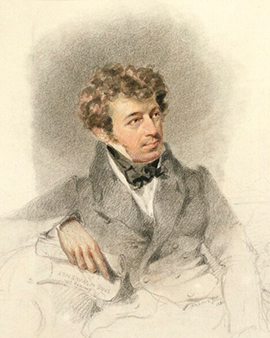


The English landscape painter James Stark grew up in Norwich. His father worked there as a dye manufacturer and successfully managed his own dye business. During this time his father, Michael Stark, created the formula for the dye "Norwich Red" and became very famous.
Br/>
Perhaps these formative impressions from his childhood also led to James Stark's early attraction to colors and eventually to painting and drawing. So it was not surprising that the 17-year-old James completed an apprenticeship with the English painter John Crome. At that time Crome was already known for his originality and his detailed paintings. John Crome worked for years as a drawing master at the Norwich School, which he had founded. He was now able to pass on his extensive experience as a teacher to James Stark, who devoted himself to painting and drawing with great determination. For James, the practice of this artistic work was central to his life and he constantly strived for perfection.
Influenced by his teacher, the young James was already able to exhibit his first works in London around 1811, a very important stage on his way to publicity. James Stark lived and worked in London for only a few years. For him it was a considerable success that as a young painter he could exhibit his paintings in the British Institution. This private institution promoted the fine arts in the United Kingdom of Great Britain until its dissolution. The English landscape and genre painter William Collins , who was very successful in his time, also had a great influence on James Stark's artistic development. When James Stark fell seriously ill in London, he returned to his home town of Norwich for twenty years. From 1840 he found many motifs for his extensive oeuvre in Windsor and finally moved to London again nine years later.
James Stark became famous above all with his oil paintings. He mainly created landscape paintings and some pictures showing the sea and the coast. He often painted rural scenes that are perfectly embedded in the landscapes. His pictures of trees, rivers and small waterfalls captivate by their attention to detail. As a painter he experimented with slightly shiny light effects and he used bright colours in his works more and more often. His watercolours, etchings and pencil drawings are also remarkable. The "Landscape of the Rivers of Norfolk", which James Stark presented to the public in 1834, was extraordinarily admired. The special thing about it is that thirty-six etchings were made of his paintings on his behalf.

The English landscape painter James Stark grew up in Norwich. His father worked there as a dye manufacturer and successfully managed his own dye business. During this time his father, Michael Stark, created the formula for the dye "Norwich Red" and became very famous.
Br/>
Perhaps these formative impressions from his childhood also led to James Stark's early attraction to colors and eventually to painting and drawing. So it was not surprising that the 17-year-old James completed an apprenticeship with the English painter John Crome. At that time Crome was already known for his originality and his detailed paintings. John Crome worked for years as a drawing master at the Norwich School, which he had founded. He was now able to pass on his extensive experience as a teacher to James Stark, who devoted himself to painting and drawing with great determination. For James, the practice of this artistic work was central to his life and he constantly strived for perfection.
Influenced by his teacher, the young James was already able to exhibit his first works in London around 1811, a very important stage on his way to publicity. James Stark lived and worked in London for only a few years. For him it was a considerable success that as a young painter he could exhibit his paintings in the British Institution. This private institution promoted the fine arts in the United Kingdom of Great Britain until its dissolution. The English landscape and genre painter William Collins , who was very successful in his time, also had a great influence on James Stark's artistic development. When James Stark fell seriously ill in London, he returned to his home town of Norwich for twenty years. From 1840 he found many motifs for his extensive oeuvre in Windsor and finally moved to London again nine years later.
James Stark became famous above all with his oil paintings. He mainly created landscape paintings and some pictures showing the sea and the coast. He often painted rural scenes that are perfectly embedded in the landscapes. His pictures of trees, rivers and small waterfalls captivate by their attention to detail. As a painter he experimented with slightly shiny light effects and he used bright colours in his works more and more often. His watercolours, etchings and pencil drawings are also remarkable. The "Landscape of the Rivers of Norfolk", which James Stark presented to the public in 1834, was extraordinarily admired. The special thing about it is that thirty-six etchings were made of his paintings on his behalf.
Page 1 / 1






